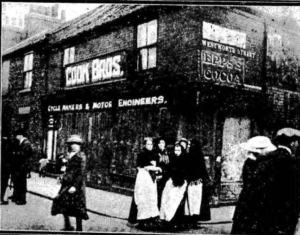The Hull Corporation recorded that 7,000 men died in the war and 14,000 were wounded, of which 7,000 were maimed. There were over a hundred Hull families that lost two or more from the same family. At least ten Hull families lost three sons and four Hull families, lost four sons. Many more returned injured by the war and would die prematurely.
About 60% of war wounds were caused by shell fire, with soldiers, three times more likely to wounded by a shell, than a bullet. Battlefield conditions were also a factor.
Trenches were an unsanitary environment where it was easy for wounds to fester and worsen. Rats, lice, vermin, poor sanitation, irregular food and the constant fear of danger, weakened the body and human spirit. Living conditions on the Western Front meant that many men suffered from gas-gangrene, trench foot, trench mouth and trench fever. The heat of the Middle East brought with it its own complications, as did the extreme cold in Salonika, where frostbite became common. Diseases such as malaria (which had major epidemics in Macedonia, Palestine and Mesopotamia, in particular), typhoid (in the Mediterranean) and dysentery (on the warmer fronts, in particular) raged amongst those stationed on these fronts. Venereal disease was another problem for forces on both sides – as well as for civilians – and a matter of great concern among government and military powers. Deaths were to continue long after the war. Hull cemeteries are littered with the graves of servicemen who died through disease, or the results of war wounds after 1918. Spanish Influenza, Tuberculosis, other ailments aggravated by war service, suicides, and mental trauma, meant may Hull men who had survived the horrors of war, died prematurely young at home.
Hull Northern Cemetery has 432, ww1 graves, Hull Western Cemetery, 495, and Hull (Hedon Road) Cemetery has 249 military graves from the First World war. Within these cemeteries are many other casualties, such as men discharged from the service and civilians killed in air raids during the war that do not have Commonwealth war graves. They can often be identified by inscriptions on family graves.
There were other deaths through accidents. For example, on 29th September 1919, two men were killed at 60 Church Street, Hull (a Cycle Shop), dissecting a 12 inch German Shell. They were Harold Cook (21) a demobbed soldier, and shop owner, and Fred Wheal (29), a former Minesweeper reservist, married with one child, at 3 Owens Square, New George Street, Hull.

Another ongoing peril was unexploded sea mines. These continued to take the lives of Hull fisherman, long after the war had ended. For example, the Hull trawler ‘Gitano’ struck a mine and was sunk with all hands on the 23rd December 1918. The Hull trawler ’Scotland’ struck a mine on the 13th March 1919 killing 7 Hull men. Two days later the steam ship ‘Durban’ exploded‘, killing another eight Hull sailors. The ‘Isle of Man’ (Hull) exploded on the 14th December 1919, killing a further seven Hull fishermen. The steam ship ‘Barbados’ exploded on the 5th November 1920, taking ten Hull men. These included the two Weaver brothers killed on the same day. Many of these seaman had survived the war, only to be its victims after.
Every man recorded on the Hull Memorial has their own unique story and there are over a thousand stories to tell, many intertwined, with the history of Hull. Naming those that died during and after the war emphasises their existence as individuals and the enormity of Hull’s loss. The potential of all these men were lost to the world, but they are now remembered here.